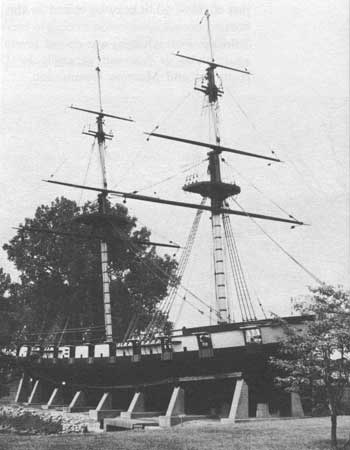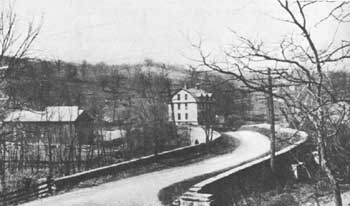





Survey of Historic Sites and Buildings
 |
DANIEL BOONE HOMESTEAD Pennsylvania |
|
| ||
Daniel Boone resided at this homestead in the wilderness from his birth, in 1734, until he was 16 years old, when his family moved to North Carolina. Boone's parents had settled at the homestead 4 years before his birth. Young Boone learned to hunt, trap, shoot, and develop other skills that he later used in his frontier explorations. Originally the homestead was a log cabin. Boone's father probably built part of the two-story stone house that now stands. The foundations of the Boone cabin formed part of the foundation wall of the present building. The Commonwealth of Pennsylvania has restored the homestead, which is open to the public. Nearby are a blacksmith shop and a bank barn. Planned for reconstruction are a log cabin, such as the one Boone lived in, a typical frontier village, and a gristmill.
 |
| Replica of the Niagara, at Erie, Pennsylvania. During the Battle of Lake Erie (1813), Commodore Oliver Hazard Perry, USN, used two flagships, the Lawrence and the Niagara. |
 |
FLAGSHIP NIAGRA REPLICA Pennsylvania |
|
| ||
The Niagara was Oliver Hazard Perry's second flagship in the Battle of Lake Erie, during the War of 1812. On September 10, 1813, Perry met a British fleet near Put-in-Bay, Ohio. Enemy guns battered his flagship Lawrence so badly that Perry had to transfer, under heavy fire, to the Niagara. Soon after the transfer the British commander, his flagship destroyed and his other ships disabled, surrendered. Perry reported to Gen. William Henry Harrison, the military commander, "We have met the enemy and they are ours." Perry's victory, Harrison's success at the Battle of the Thames, and Thomas Macdonough's triumph in 1814 at the Battle of Plattsburgh Bay, on Lake Champlain, blocked British invasion efforts from Canada. The present replica of the Niagara is the second reconstruction of the vessel and is open to the public. It contains a 78-foot section of the original black keel.
 |
| S-Bridge, Pennsylvania, was one of several along the National Road. The route today is followed generally by U.S. 40. Courtesy, Pennsylvania Historical and Museum Commission. |
 |
S-BRIDGE (National Road) Pennsylvania |
|
| ||
This bridge is one of the few remaining landmarks in Pennsylvania that commemorates the National (Cumberland) Road, over which once passed thousands of westward emigrants. Begun in 1811, the road originated at Cumberland, Md., and by 1817 it had reached Uniontown, Pa. In 1818 it reached the Ohio River at Wheeling, W. Va., which remained its western terminus for several years. In 1836 the Federal Government turned over Pennsylvania's section of the road, consisting of about 75 miles, to the Commonwealth, which charged tolls. In the 20th century, the realinement of U.S. 40 bypassed the bridge. At that time its west end was damaged, and the structure is now only in fair condition. Sitting just off U.S. 40, it may be visited by the public.
 |
 |
http://www.cr.nps.gov/history/online_books/founders-frontiersmen/sitee17.htm
Last Updated: 29-Aug-2005